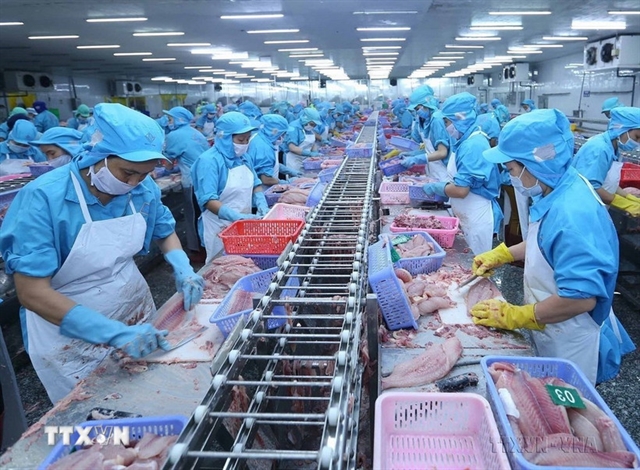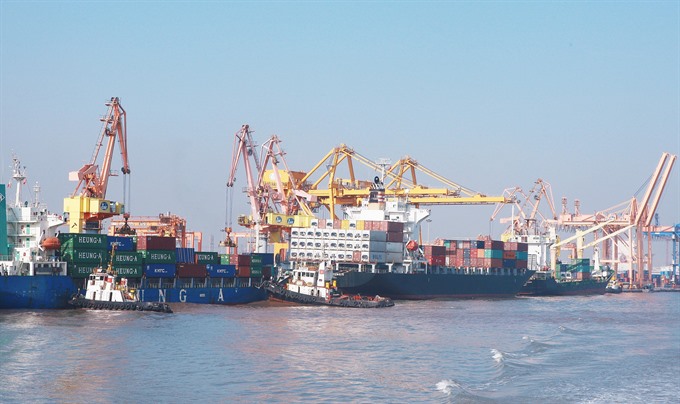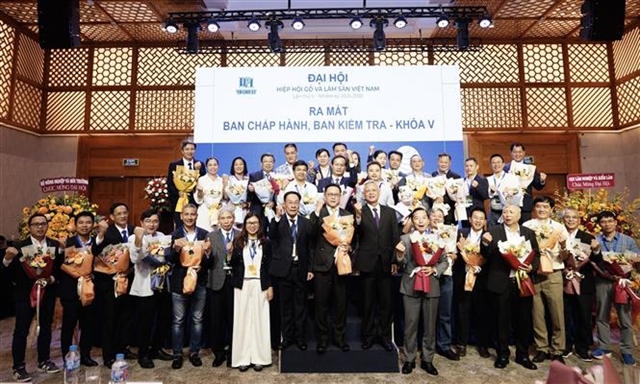 Economy
Economy

Cargo shipping has seen positive growth in the first six months of the year, with 254.8 million tonnes handled via the country’s seaports, up 17 per cent on last year.
 |
| Cargo handled at the Hải Phòng Port, one of the three biggest port complexes in Việt Nam. — Photo VNA |
HÀ NỘI — Cargo shipping has seen positive growth in the first six months of the year, with 254.8 million tonnes handled via the country’s seaports, up 17 per cent on last year.
The Việt Nam Maritime Administration (under the Ministry of Transport) reported that 8.7 million TEUs (20-foot equivalent units) of freight containers were processed, up 28 per cent against the same period last year, and fulfilling 57 per cent of the target set for 2018.
During the period, 38 Vietnamese container ships carried about 69.9 million tonnes of cargo, representing a year-on-year rise of 9 per cent, according to the administration.
Foreign journeys
According to Nguyễn Đình Việt, deputy director of the Việt Nam Maritime Administration, despite the positive growth in the first half of the year, there remains inherent weaknesses that need to be addressed.
“The Vietnamese sea fleet still doesn’t have any container ships capable of long-distance journeys, such as to the United States, Europe and Africa. These journeys are usually undertaken by foreign fleets,” Việt told Thời báo Kinh tế Việt Nam (Vietnam Economic Times).
The Vietnamese fleet currently commands about 10 per cent of the market share and mostly handles short-distance transport such as China, Japan, South Korea, or within the Southeast Asian region.
To push the development of maritime transport in a sustainable direction, there needs to be a strong logistics system.
Currently, there are nearly 297,000 firms in the country registered to operate in the logistics sectors, with 0.43 per cent of them, or around 1,300, are providers of maritime logistics services.
“There are a decent number of domestic logistics firms in Việt Nam but their market share is fairly small, with most of them only providing a certain service-related part in the logistics chain, or acting as agents for foreign maritime shipping companies,” Việt said.
Most ports are small-scale, operating inefficiently, and lacking modern loading and unloading infrastructure.
Country-wide, there are currently 68 active maritime towing firms who are operating without much difficulty, Việt said.
After a period of unhealthy competition between the towing firms in the last few years, the transport ministry has issued a pricing framework for loading and unloading cargo tasks, to prevent price dumping and ensure equality between businesses.
Weak connectivity
Nguyễn Văn Công, deputy minister of transport, said that many import-export firms are still not fully aware of the importance of logistics. They usually only understand logistics as purely transport, without knowing that it contains many different activities.
“In the last five or six years, the transport ministry has implemented its logistics development project, aimed at promoting multimodal transport [cargo transport done by a single carrier but using different transport modes], in which sea routes and inland waterways will be fully utilised,” Công said.
However, connectivity between modes of transport has not seen considerable improvement. In rail freight transport, even with the key route of the North-South railway, there is a lack of appropriate warehouses or equipment to provide services such as storage, loading and unloading, delivery, or short-distance transportation – especially tailored for cargo containers.
“This shortage must be corrected before we could hope for future logistics development,” deputy minister Công stressed.
In the last half of the year, the transport ministry has asked the customs department to facilitate legal document revisions, especially in terms of pricing schemes to prevent arbitrary price hikes by foreign companies.
In the future, efforts and resources would also be spent on dredging operations to ensure uninterrupted traffic in seaports.
Việt Nam has a total of 42 public navigation lines stretching 935.9km and 10 specialised navigation lines, with major maritime shipping routes including Hòn Gai – Cái Lân, Hải Phòng in the north and Đà Nẵng or Vũng Tàu – Thị Vải in the south. — VNS
Box: PM calls for measures to reduce logistics costs, improve competitiveness
Prime Minister Nguyễn Xuân Phúc has signed a directive on reducing logistics costs and connecting the transport infrastructure system.
The directive noted that the Government leader approved an action plan to increase competitiveness and develop logistics services in Việt Nam until 2025 on February 14, 2017. After more than a year of implementation, agencies and units have exerted efforts to achieve set targets.
However, the transport infrastructure system has developed unevenly, while links between modes of transportation have remained ineffective. Logistics centres to connect Việt Nam with other countries have yet to be built, leading to high logistics costs, harming the competitiveness of the Vietnamese economy.
To cut logistics costs and promote the connectivity of the transport infrastructure system, the Prime Minister asked ministries, sectors and localities to focus on six main task groups under the action plan. The task groups are: completing policies and laws on logistics services, increasing the quality of logistics infrastructure, improving the capacity of enterprises and quality of services, developing the logistics market, increasing the quality of human resources and raising public awareness of the importance of logistics services.
The Government leader assigned the transport ministry to tweak legal documents, reform administrative procedures, cut business conditions, simplify inspection procedures and intensify connectivity between modes of transportation.
The ministry was also urged to hasten the restructuring of the domestic transportation market by reducing the market share of road transportation and increase the market shares of sea, railway and internal waterway transportation.
The PM requested the Ministry of Industry and Trade to continue working with ministries and sectors to complete policies attracting investment in logistics infrastructure and develop logistics infrastructure in combination with e-commerce.
The Ministry of Planning and Investment was ordered to lure investment in key logistics centres. — VNS




